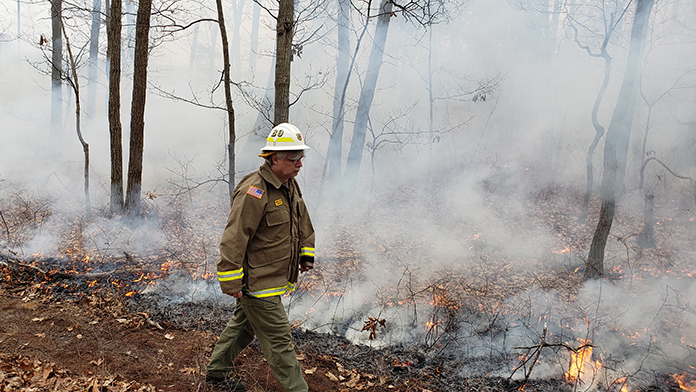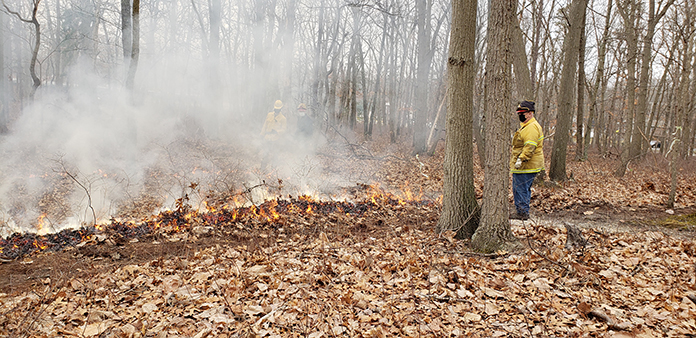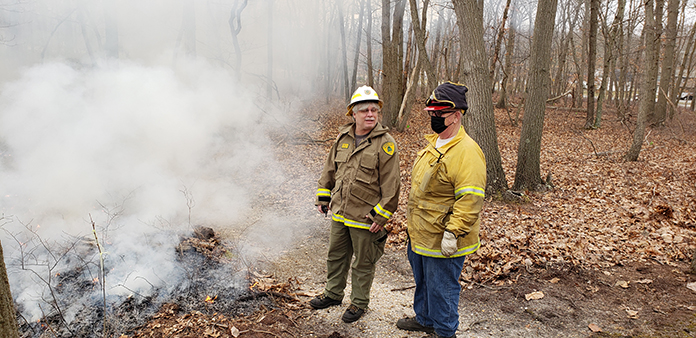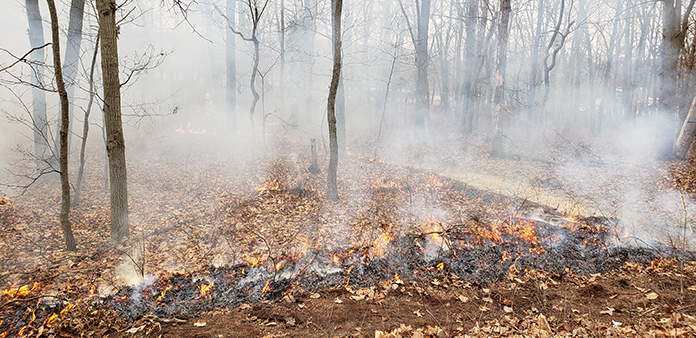
JACKSON – Students of the Jackson Liberty High School were learning about burning. Controlled burning that is, as part of a program that partnered them with members of the State’s Forest Fire Service.
The program began a few years ago and while school officials feared the recent fire along Route 70 in Lakewood and Brick may cause this year’s demonstration to be canceled, it proved an ideal time to bring awareness about controlled fires and the ground conditions that cause wild fires.
JLHS Principal Geoff Brignola noted the lesson was held right on property near the high school. It involved 34 students who work with the “DNA Learning Center which is part of the Cold Spring Harbor Laboratory on Long Island.”

“We got a grant through Sustainable New Jersey which we’ve been partners with for a few years now and NJEA (New Jersey Education Association) and the Lakehurst Naval Base and they are doing DNA bar coding with ants, getting the DNA out of them, bar coding them,” Brignola said. He credited JLHS Assistant Principal Dave Bender whose off-time passion is fighting fires and working with the NJ Forest Fire Service.
“They are going to look at ants in an area that hasn’t been burned for DNA and compare them to ants that have been living in an area that has. It is giving them a chance to actually do science and they are learning about the different eco systems that are effected by burns and can’t have more timely a lesson that what just happened,” Brignola said regarding the Route 70 wildfire.
Communications Manager Allison Erwin noted that another benefit of the program is it provided students of the school district’s Jackson TV program to come out and produce its second segment on the program.
During that segment Maris Gabliks, a retired state fire warden, said “this is one of the first times we are doing a prescribed fire project in conjunction with a high school in New Jersey. What we are trying to do is educate the students that live in Jackson Township and raise their awareness of wild fires and to educate them on the benefits of prescribed fire.”

Gabliks noted the program allows students to study fire ecology right on land adjacent to their school. “What better than to have a classroom in a forest area right next to your school?” he said in the Jackson TV segment.
Controlled burning is “pretty much a way to reduce the fuel. Controlled burning is a method of prescribed burning where we actually take a piece of the woods that has naturally had a fire in it in its history but we reduce the fuel.” They burn it while there are firefighters, trucks and equipment nearby. It’s much safer than if this fuel caught fire when no one was around, said Section Fire Warden Deale Cary.
Division Fire Warden Shawn Judy said, “we are conducting a very small prescribed burn, a quarter of an acre. We strive every year to conduct prescribed burning and to accomplish upward of 20,000 acres. When you return to this site in May and June you will see a healthy forest and an opportunity for it flourish. You may see plants and animals that you didn’t see before.”
Student experiments included taking soil samples and dehydrating the dirt and using distilled water to measure the nitrates and the PH balance of the dirt and to examine the soil horizon.
JLHS Senior Madison Patterson who took part in the exercise for her biology class said they will be taking samples of DNA, learning different species of insects and plants that live in this area. “We will be learning how that changes over time with these prescribed burns and if these burns actually harm or help these woods in general.”
“We will be learning DNA bar coding which is how to identify a species by DNA,” she added. Patterson said that she has aspirations of having a career in something similar. “I’ve always been interested in biology in general so just learning about all the different methods of how life works and how things survive and adapt in their environments is very interesting to me.”

“It is a unique opportunity for the kids,” JLHS environmental teacher Ted Werner said. “It is unique in New Jersey. It is to my knowledge the only time students get to see a prescribed burn. We’ll get to see what happens over the course of the next few years as we continue the project.”
Cary said the prescribed burns occur during the off season of the year in the winter and spring “because we take advantage of the cooler temperatures and the forests being open so it allows the forest to dry out.”
“It is great to do labs but it is even better to do them in a natural setting because this is where science actually happens. Doing sciences means actually getting out and getting dirty and playing,” Werner said.
The recent lesson was especially welcome given the students’ time away from the classroom and outside activities given the ongoing COVID-19 pandemic.
Superintendent Nicole Pormilli said, “Mr. Bender has really been passionate about this with his interest in the fire fighting field and bringing learning to our students. We have incredible teachers who jump right on and say ‘yes let’s do stuff’ and fulfill our philosophy here to do authentic learning not just textbook learning. It is particularly timely because of the fire that just happened in Lakewood.”
Bender said “students are able to come out here and pretty much stand within 50 to 60 feet of a fire being put on the ground with professionals with 30-35 years’ experience explaining the process to them.”
He noted that last year representatives from the Forest Research Education Center a couple miles away were present. He also noted that students had an opportunity to see a vocation. The students’ research will be part of an ongoing decade long project.






